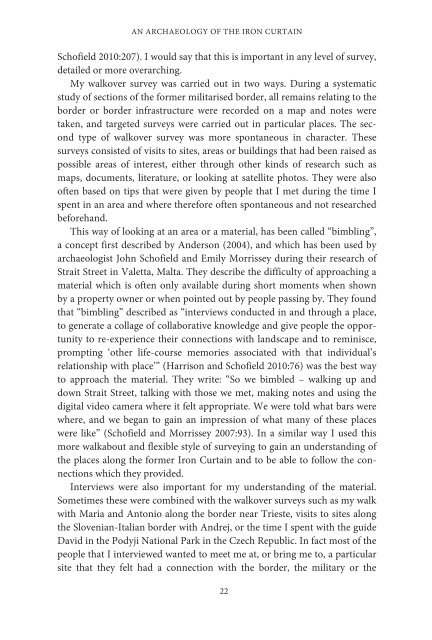1JZGauQ
1JZGauQ
1JZGauQ
You also want an ePaper? Increase the reach of your titles
YUMPU automatically turns print PDFs into web optimized ePapers that Google loves.
AN ARCHAEOLOGY OF THE IRON CURTAIN<br />
Schofield 2010:207). I would say that this is important in any level of survey,<br />
detailed or more overarching.<br />
My walkover survey was carried out in two ways. During a systematic<br />
study of sections of the former militarised border, all remains relating to the<br />
border or border infrastructure were recorded on a map and notes were<br />
taken, and targeted surveys were carried out in particular places. The second<br />
type of walkover survey was more spontaneous in character. These<br />
surveys consisted of visits to sites, areas or buildings that had been raised as<br />
possible areas of interest, either through other kinds of research such as<br />
maps, documents, literature, or looking at satellite photos. They were also<br />
often based on tips that were given by people that I met during the time I<br />
spent in an area and where therefore often spontaneous and not researched<br />
beforehand.<br />
This way of looking at an area or a material, has been called “bimbling”,<br />
a concept first described by Anderson (2004), and which has been used by<br />
archaeologist John Schofield and Emily Morrissey during their research of<br />
Strait Street in Valetta, Malta. They describe the difficulty of approaching a<br />
material which is often only available during short moments when shown<br />
by a property owner or when pointed out by people passing by. They found<br />
that “bimbling” described as “interviews conducted in and through a place,<br />
to generate a collage of collaborative knowledge and give people the opportunity<br />
to re-experience their connections with landscape and to reminisce,<br />
prompting ‘other life-course memories associated with that individual’s<br />
relationship with place’” (Harrison and Schofield 2010:76) was the best way<br />
to approach the material. They write: “So we bimbled – walking up and<br />
down Strait Street, talking with those we met, making notes and using the<br />
digital video camera where it felt appropriate. We were told what bars were<br />
where, and we began to gain an impression of what many of these places<br />
were like” (Schofield and Morrissey 2007:93). In a similar way I used this<br />
more walkabout and flexible style of surveying to gain an understanding of<br />
the places along the former Iron Curtain and to be able to follow the connections<br />
which they provided.<br />
Interviews were also important for my understanding of the material.<br />
Sometimes these were combined with the walkover surveys such as my walk<br />
with Maria and Antonio along the border near Trieste, visits to sites along<br />
the Slovenian-Italian border with Andrej, or the time I spent with the guide<br />
David in the Podyji National Park in the Czech Republic. In fact most of the<br />
people that I interviewed wanted to meet me at, or bring me to, a particular<br />
site that they felt had a connection with the border, the military or the<br />
22




